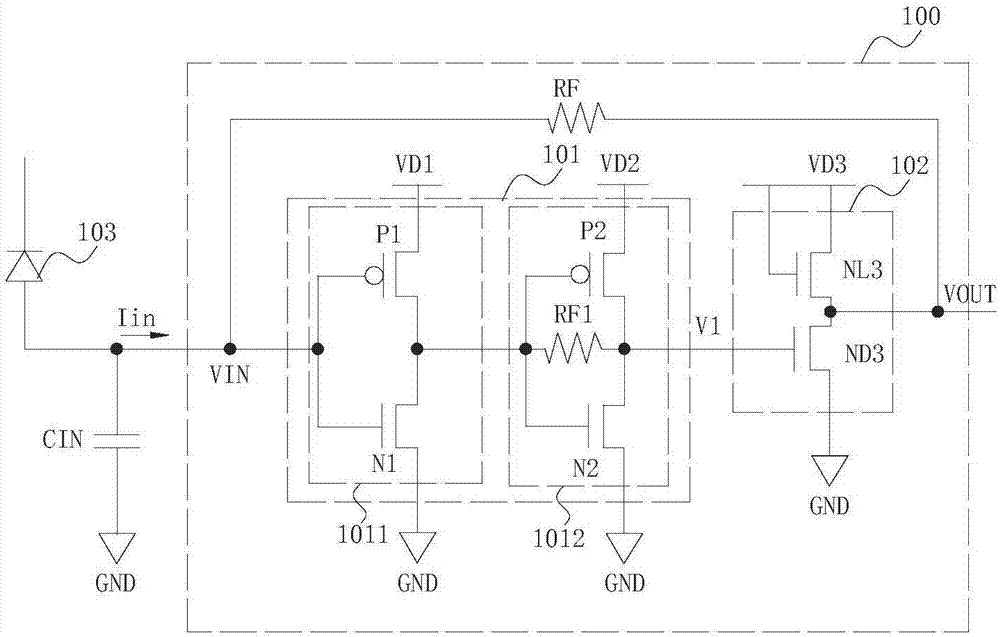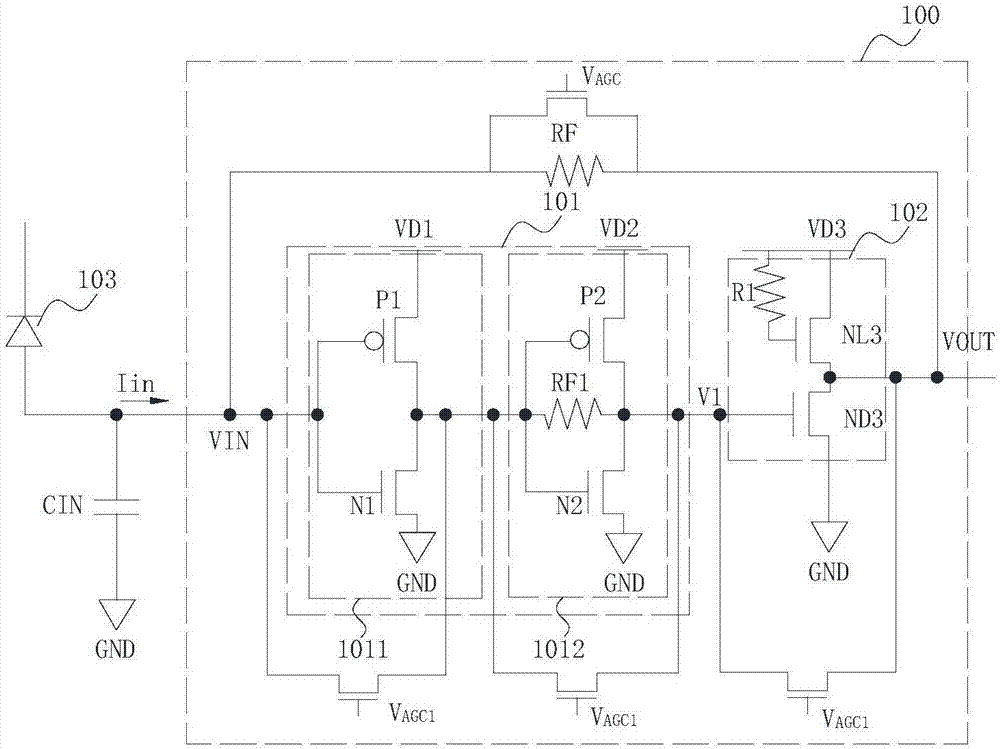Trans-impedance amplifier
A transimpedance amplifier and two-stage amplification technology, which is applied in the field of COMS, can solve the problems of large equivalent capacitance, small gain-bandwidth product, and difficulty in further increasing the value, so as to reduce input noise and increase sensitivity.
- Summary
- Abstract
- Description
- Claims
- Application Information
AI Technical Summary
Problems solved by technology
Method used
Image
Examples
Embodiment 1
[0030] The inverting amplifying unit 102 includes a third N-type transistor NL3 and a fourth N-type transistor ND3, the first terminal and the second terminal of the third N-type transistor NL3 are used to receive the third DC voltage VD3, and the third terminal is used to output amplifying the voltage signal VOUT; the first end of the fourth N-type transistor ND3 is coupled to the third end of the third N-type transistor NL3, and the second end is coupled to the output end of the equivalent secondary amplification module 101 for receiving the first voltage Signal V1, the third terminal is grounded.
[0031] The equivalent secondary amplifying module 101 of the transimpedance amplifier 100, the inverting amplifying unit 102 and the feedback resistor RF form a three-stage operational amplifier, and the inverting amplifying unit is used as one of the first-stage amplifying units in the three-stage operational amplifier, using two N-type The structure of the transistor is used to...
Embodiment 2
[0034] Such as figure 2 As shown, as another embodiment of the present invention, the inverting amplifying unit 102 further includes a resistor R1, one end of the resistor R1 receives the third DC voltage, and the other end is coupled to the second end of the third N-type transistor N3. The two terminals are coupled with a resistor, so that the resistor R1 acts as an active inductor, which can increase the bandwidth of the inverting amplifier unit 102 , thereby increasing the gain-bandwidth product of the entire transimpedance amplifier 100 .
[0035] In order to reduce the voltage drop across the third N-type transistor NL3, in the embodiment of the present invention, the third N-type transistor NL3 adopts Native NFET.
[0036] In another embodiment of the present invention, the positions of the equivalent secondary amplifying module 101 and the inverting amplifying unit 102 are exchanged, and the input end of the inverting amplifying unit 102 is coupled to the photodiode 10...
Embodiment 3
[0038] Such as image 3 As shown, as another embodiment of the present invention, each of the three units for signal amplification may be provided with an N-type transistor between its own input terminal and output terminal, and an N-type transistor is also provided at both ends of the feedback resistor. This N-type transistor enables AGC control (Automatic Gain Control) of the transimpedance amplifier.
[0039] In addition to the above-mentioned functions, if noise and sensitivity are not the main design goals of the transimpedance amplifier 100, the conductance of the P-type transistor and the N-type transistor in the transimpedance amplifier 100 can be reduced. If the conductance is reduced, the current consumption will be reduced, thereby realizing transimpedance amplifier 100. The power consumption of the impedance amplifier 100 is reduced.
PUM
 Login to View More
Login to View More Abstract
Description
Claims
Application Information
 Login to View More
Login to View More - R&D
- Intellectual Property
- Life Sciences
- Materials
- Tech Scout
- Unparalleled Data Quality
- Higher Quality Content
- 60% Fewer Hallucinations
Browse by: Latest US Patents, China's latest patents, Technical Efficacy Thesaurus, Application Domain, Technology Topic, Popular Technical Reports.
© 2025 PatSnap. All rights reserved.Legal|Privacy policy|Modern Slavery Act Transparency Statement|Sitemap|About US| Contact US: help@patsnap.com



